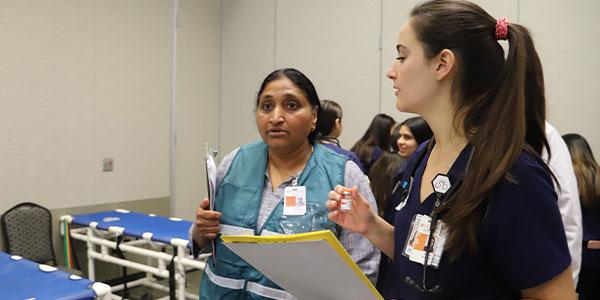Mass casualty simulation trains students on emergency response, collaboration

A group of students provide emergency care to a man with a mock wound as a part of the mass casualty simulation. (Photo by UTHealth Houston)
Gunshot “victims” lay stricken on the ground – some writhing in pain calling out for help while others lay motionless with more serious wounds that could quickly turn fatal.
The injured spread across the courtyard of The Denton A. Cooley, MD and Ralph C. Cooley, DDS University Life Center, were part of a mass casualty incident simulation where students from UTHealth Houston responded to a fictional mass shooting to provide mock, lifesaving medical care to about 40 victims, played by actors.
The March 3 scene was part of the UTHealth Houston Center for Interprofessional Collaboration’s annual Mass Casualty Incident Simulation.
The drill highlights the center’s mission to promote education, practice, and research within the framework of a health care team. Through the center, students from all UTHealth Houston schools have opportunities to gain knowledge and skills for interprofessional models of care.
An estimated 400 students from McGovern Medical School at UTHealth Houston, Cizik School of Nursing at UTHealth Houston, and UTHealth Houston School of Dentistry participated in the two-part exercise, which was broken into multiple sessions throughout the day to accommodate the large number of students.
The trainees walked into the courtyard without prior knowledge of what they would encounter, or the type of wounds they would see.
They approached the wounded and assessed the injuries, applied first aid, checked vital signs, maneuvered patients who needed to be moved, and provided comfort while they waited for the victims to be transported to fake hospital emergency rooms.
“Help is on the way. We’re just going to stay with you until the ambulance gets here,” one student said to a man laying on the ground, clutching his chest with a grimaced face.
Instructors and facilitators from various UTHealth Houston schools observed the scene and the students’ ability to collaborate, communicate, and strategize their care in the emergency scenario.
Facilitators, made up of faculty from the three schools, said their job was to give feedback after observing the ways the students work together, and how efficiently a leader emerges from the group to take charge of the scene.
“A lot is driven by personality and comfort zone,” said John A. Valenza, DDS, dean of the School of Dentistry. “It’s about applying what each student brings to the table, and what each can contribute to the cause.”
Valenza has participated in the simulations for many years and said they are a great way to foster interprofessional collaboration.
“I’m a huge, huge fan of the simulations, period. There’s no substitute for a real or simulated, real-life scenario,” he said.
Rotating in groups, the students addressed a mass casualty event in the courtyard, then went into a hospital simulation where the patients from the shooting were brought into an already busy emergency room.

A group of UTHealth Houston students treat wounds of a mock "victim" in a simulated shooting incident as their care is assessed by facilitators. (Photo by UTHealth Houston)
One patient was experiencing chest tightness; a pregnant woman was having abnormal pain and worried about her fetus; and another man was in mental distress and seemed to have caused harm to himself.
The students began attending to these patients, when all of the sudden one of the facilitators shouted to the room, “We’ve just received news of a mass shooting! We’re going to be getting the injured any minute!”
In an instant, Justin Mehr, a fourth-year medical school student, began organizing his classmates into teams and began logging bed space and availability on a large whiteboard on the wall.
Later, in a debriefing of the exercise, his classmates reported that he had showed the most leadership in that portion of the day.
Mehr said the simulation showed him the importance of training exercises.
“No one mass casualty situation may completely mirror the other, but to have a simulation that allows us to experience the teamwork, leadership, and action required was so incredibly helpful going forward into our next chapter as health care workers,” he said.
Gunshot victims were rolled into the room in waves, just like a real emergency department would receive patients from a nearby incident.
One man was in shock from the incident when he arrived in a wheelchair, asking the care teams if he’d been shot and that he remembered hearing gunshots. The students didn’t miss a beat as they began applying pressure to an obvious gunshot wound in his abdomen and offering him reassurance.

A UTHealth Houston student coordinates triage of mock patients in the simulated emergency room. (Photo by UTHealth Houston)
One woman barged into the room loudly demanding to see her husband, frantic from not being able to find him.
Two students quickly subdued her excitement and told her they would find her loved one.
Another fourth-year medical student, Robert J. McAdams, who plans to practice internal medicine, spent time with a chest pain patient taking a history and reading heart test results from computer screen.
“Despite the chaos, we divided up our roles pretty well,” McAdams said. “Having one person running the show helped.”
Martin Osorio, a fourth-year medical school student, was a part of the first group of the day to go through the simulation.
“You can never be fully prepared for something like that, but this exercise taught me some basic lessons in how to triage patients and work with people of different health care experiences to help out the best we can in a tough spot, Osorio said.“The school did an incredible job of setting up a simulation that taught us how to step up and work on a team if we ever find ourselves in a situation like this.”



